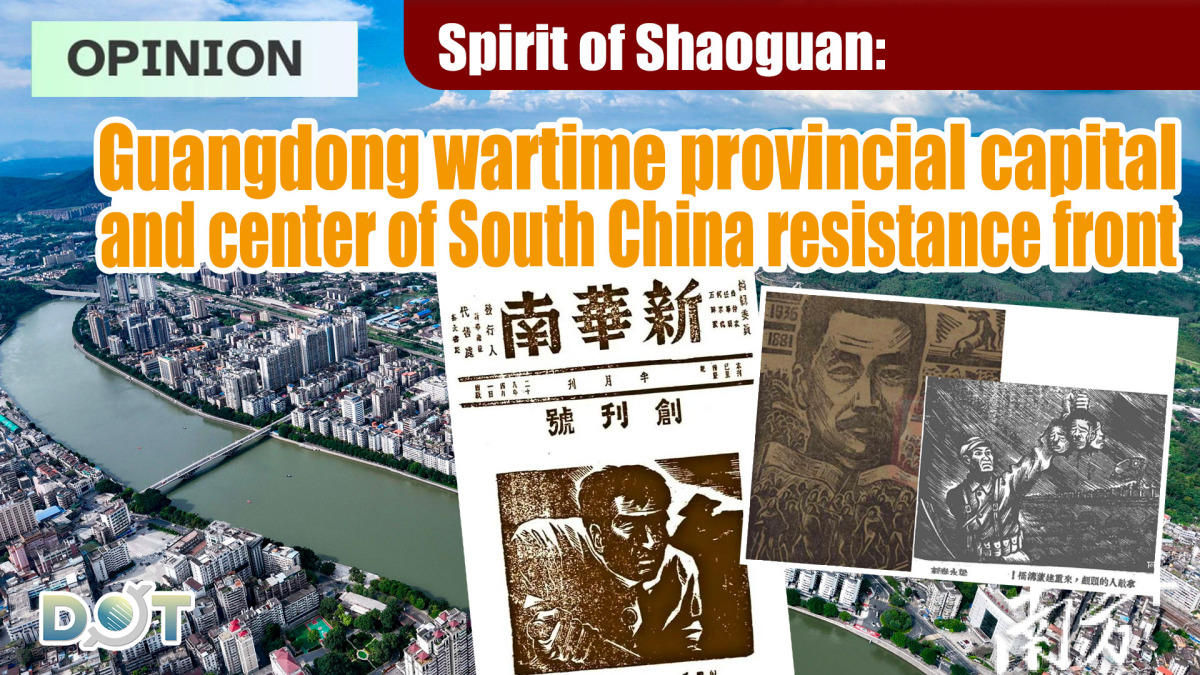
By Liu Yu
From the pioneering spirit of "cutting through mountains to pave the way" to the passionate dedication of "standing firm as a pillar amid challenges," and further to the revitalizing vanguard of "bravely riding the tides," the resilience and responsibility deeply ingrained in the blood of the people have become the most profound echoes of Shaoguan's land.
Turning back the clock to the 1930s, when the iron heels of Japanese invaders trampled the nation, and the survival of the country hung in the balance, this mountainous city in northern Guangdong, located over 200 kilometers from the provincial capital Guangzhou, shouldered a great responsibility: Shaoguan became the wartime provisional capital of Guangdong.
Situated at the junction of Guangdong, Hunan, and Jiangxi provinces, Shaoguan serves as a "golden gateway" and "bridgehead" for the Guangdong-Hong Kong-Macao Greater Bay Area to extend its influence into the inland regions.
Ancient Pass and Trail: A Millennia-Old North-South Thoroughfare
When speaking of Shaoguan, one cannot overlook the Dayu Ridge (also known as Meiling), one of the five ridges of Nanling. In today's era of airplanes and high-speed trains, it is hard to imagine the determination required to cross the towering Dayu Ridge in ancient times. Its majestic and perilous terrain posed an almost insurmountable barrier for travelers.
It was not until Zhang Jiuling, a renowned chancellor of the Tang Dynasty, petitioned Emperor Xuanzong of Tang to open the Meiguan Ancient Trail, citing the hardships of the extreme terrain. This bluestone trail, carved step by step with primitive techniques, traversed mountains over 800 meters above sea level, unlocking the north-south economic artery. It facilitated the flow of goods and people between the Central Plains and Lingnan, turning Shaoguan into a commercial hub and fostering open economic and cultural exchanges. Thus, it became a millennia-old thoroughfare connecting the north and south.
"Zhang Jiuling, a native chancellor of Shaoguan, promoted education and fostered a thriving cultural atmosphere," said Wu Tuqing, former director of the Shaoguan Local History Office. The integrity and patriotic spirit of this "finest figure of Lingnan over the millennia" are deeply embedded in the spiritual fabric of Shaoguan's people. The imprint of "Jiuling's Elegance" can be found throughout Shaoguan—there are Fengdu villages in Renhua's Zhoutian and Shixing's Aizi, the bustling Fengdu Pedestrian Street in the city center, Fengdu study rooms scattered across urban and rural areas, and numerous primary and secondary schools named "Jiuling" or "Fengdu."
Zhuji Alley, located at the southern end of the Meiguan Ancient Trail and nine kilometers from downtown Nanxiong, is a significant landmark in ancient immigration history, bearing witness to the migration of over 180 clans. As a key stop for migrants from the Central Plains moving south, hundreds of thousands of settlers passed through here before dispersing across the Pearl River Delta, bringing clan culture and farming techniques to Lingnan. The southward migration of the Hakka people also left its mark here, with traditional enclosed houses and folk songs. Many families paused here before spreading throughout the Pearl River Delta, making it a common root for the Cantonese people.
Years of migration and integration have shaped Shaoguan's open, inclusive, and diverse character, blending Central Plains culture with Lingnan culture, and Hakka culture with Cantonese culture.
Wartime Provisional Capital: Guangdong's Anti-Japanese War Base
In October 1938, the shadow of war loomed over China. With the fall of Guangzhou, South China was in crisis. The Guangdong Provincial Committee of the Communist Party of China relocated north to Shaoguan, initially operating from a civilian house near the Eighth Route Army's office in Shaoguan. It later moved to Yaokeng in Nanxiong, Hongwei in Shixing, Wuliting in Shaoguan, and other locations. Under the leadership of comrades such as Zhang Wenbin and Li Dalin, it propelled the anti-Japanese efforts in Guangdong, making Shaoguan the center of Guangdong's resistance.
Yaokeng Village: Former Site of the Guangdong Provincial Committee
"The relocation of the Northern Guangdong Provincial Committee to Wuliting allowed the Communist Party organization to command from the front lines," said Huang Le, head of the Party History Section of the Shaoguan Party History Research Office of the Communist Party of China. "This location was a vital transportation hub, close to rivers, railways, and train stations. Its selection was also a result of united front work." After the Northern Guangdong Provincial Committee was established in December 1940 (following the dissolution of the Guangdong Provincial Committee, the Northern and Southern Guangdong Provincial Committees were formed, with the Northern Committee overseeing party organizations in the East, West, and North River regions), the provincial committee's radio station remained in Hongwei to carry out missions. Over a year, the station transmitted over 100 messages. Each "tick" pierced through layers of blockades, turning into intangible instructions that kept the Northern Guangdong Provincial Committee closely connected with party organizations at all levels, leading to countless heroic battles.
To strengthen the leadership of anti-Japanese war culture, the provincial committee established cultural groups and a cultural work committee. Progressive cultural workers formed cultural organizations, founded progressive publications, and engaged in unprecedented literary and artistic creations, making Shaoguan a key cultural hub on par with Kunming, Chengdu, and Guilin.
Promoting Unity and Resistance: Home to over 20 Progressive Publications
At that time, Shaoguan was home to over 20 progressive publications, including "New South China 新華南", "North River Daily", and "Youth Vanguard Communication". Promoting unity and resistance was the mainstream voice of these publications. "New South China", founded by the Guangdong Provincial Committee of the Communist Party of China on April 1, 1939, was publicly distributed under the guise of a united front. It reached a wide audience and published over 30 issues under difficult conditions, earning the title "Bugle Call of the South China Resistance."
"New South China" consistently raised the banners of resistance, unity, and progress, publishing sharp articles that exposed social contradictions and criticized political ills, earning it great popularity among readers. Exposing the atrocities of the Japanese invaders was one of its main themes.
For example, the article "Shunde Under the Brutal Enemy's Trample" accused Japanese troops of atrocities after occupation, describing the humiliation and violence women endured during inspections and revealing the cruel actions of the Japanese army. Another article, "Humiliated Anbu," pointed out that the Japanese army attempted to divide the Chinese people through a "using Chinese to control Chinese" strategy and relied on economic plunder to support their aggression.
In response to Wang Jingwei's surrender rhetoric, "New South China" swiftly counterattacked, publishing articles condemning his treason and organizing a movement to denounce Wang, igniting anti-Japanese fervor in South China. The publication was regarded as a credible voice, profoundly influencing revolutionary cadres and youth. It was recognized as an authoritative publication after the founding of New China.
Following the victories in the first and second Northern Guangdong battles, many tertiary institutions and secondary schools from Guangzhou, Hong Kong, and Macau, represented by National Sun Yat-sen University, relocated to Shaoguan. For a time, Shaoguan became a veritable "university town." College and secondary school students carried out anti-Japanese salvation propaganda through various forms, turning this mountainous city into an academic hub and an important base for cultural propaganda.
On the land of Shaoguan, the people's anti-Japanese armed forces, under the leadership of the Guangdong Provincial Committee (Northern Guangdong Provincial Committee), grew steadily. They started the South China battlefield, one of the three major enemy rear battlefields in the country, making an indelible contribution to the victory of the Anti-Japanese War.
(Source: Nanfang Daily, Shaoguan Chronicles Institute)
Related News:
Deepline | HK's overlooked history of War of Resistance and scholar who refused to let it fade




















Comment